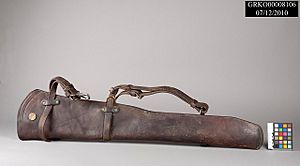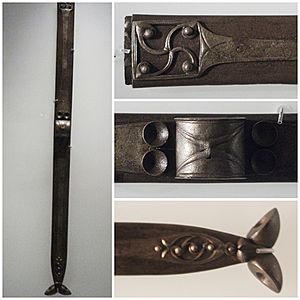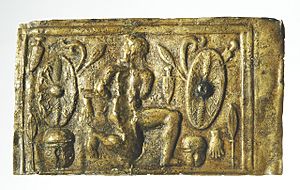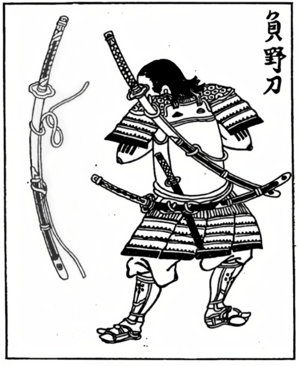Scabbard facts for kids

A scabbard is a sheath for holding a sword, knife, or other large blade. As well, rifles may be stored in a scabbard by horse riders. Military cavalry and cowboys had scabbards for their saddle ring carbine rifles and lever action rifles on their horses for storage and protection. Scabbards have been made of many materials over the millennia, including leather, wood, and metals such as brass or steel.
Most commonly, sword scabbards were worn suspended from a sword belt or shoulder belt called a baldric.
Antiquity
Wooden scabbards were usually covered in fabric or leather; the leather versions also usually bore metal fittings for added protection and carrying ease.
Japanese blades typically have their sharp cutting edge protected by a wooden scabbard called a saya.
Many scabbards, such as ones the Greeks and Romans used, were small and light. They were designed for holding the sword rather than protecting it.
All-metal scabbards were popular items for a display of wealth among elites in the European Iron Age, and often intricately decorated. Little is known about the scabbards of the early Iron Age, due to their wooden construction. However, during the Middle and late Iron Ages, the scabbard became important especially as a vehicle for decorative elaboration. After 200 BC fully decorated scabbards became rare.
A number of ancient scabbards have been recovered from weapons sacrifices, a few of which had a lining of fur on the inside. The fur was probably kept oily, keeping the blade free from rust. The fur would also allow a smoother, quicker draw.
Modern era
Entirely metal scabbards became popular in Europe early in the 19th century and eventually superseded most other types. Metal was more durable than leather and could better withstand the rigours of field use, particularly among troops mounted on horseback. In addition, metal offered the ability to present a more military appearance, as well as the opportunity to display increased ornamentation. Nevertheless, leather scabbards never entirely lost favour among military users and were widely used as late as the American Civil War (1861–65).
Some military police forces, naval shore patrols, law enforcement and other groups used leather scabbards as a kind of truncheon.
Scabbards were historically, albeit rarely, worn across the back, but only by a handful of Celtic tribes, and only with very short lengths of sword. This is because drawing a long, sharp blade over one's shoulder and past one's head from a scabbard on the back is relatively awkward, especially in a hurry, and the length of the arm sets a hard upper limit on how long a blade can be drawn at all in this way.
Common terms
The metal fitting where the blade enters the leather or metal scabbard is called the throat, which is often part of a larger scabbard mount, or locket, that bears a carrying ring or stud to facilitate wearing the sword. The blade's point in leather scabbards is usually protected by a metal tip, or chape, which, on both leather and metal scabbards, is often given further protection from wear by an extension called a drag, or shoe.
Images for kids
-
Mounting for a Japanese short sword (wakizashi) 18th century. Metropolitan Museum of Art
See also
 In Spanish: Vaina para niños
In Spanish: Vaina para niños






